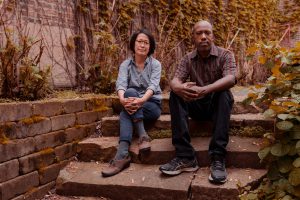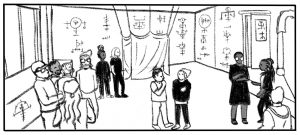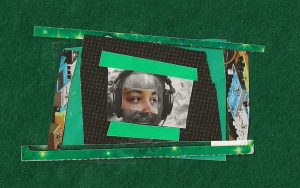As I walk into the gallery space, I’m greeted by vibrant and seemingly disparate groups of artworks. On one wall, there are bold, schematic line drawings of Chicago architecture. To my right are totem-like sculptures with intricate embellishments. Across the way is a collection of flat landscapes with skewed perspectives. This is Chicago Calling: Art Against the Flow, an exhibition on view at Intuit: The Center for Intuitive and Outsider Art as part of Art Design Chicago.
Throughout the show, it seems that the curators Kenneth Burkhart and Lisa Stone refrain from hand-holding me through a chronological, step-by-step development of an artist or artistic movement. As I trace my way through the space, pausing at each work, I soon realize that the absence of a consistent, linear narrative may be the point. Intuit’s mission is to celebrate the power of outsider art, which they define on their website as “the works of artists who demonstrate little influence from the mainstream art world and who instead are motivated by their unique personal visions.” With this in mind, it makes sense that Intuit offers up a different type of exhibition–one that doesn’t mimic the blockbuster shows of larger art institutions in favor of offering up something more similar to a map of the landscape of major players in Chicago’s outsider art scene.
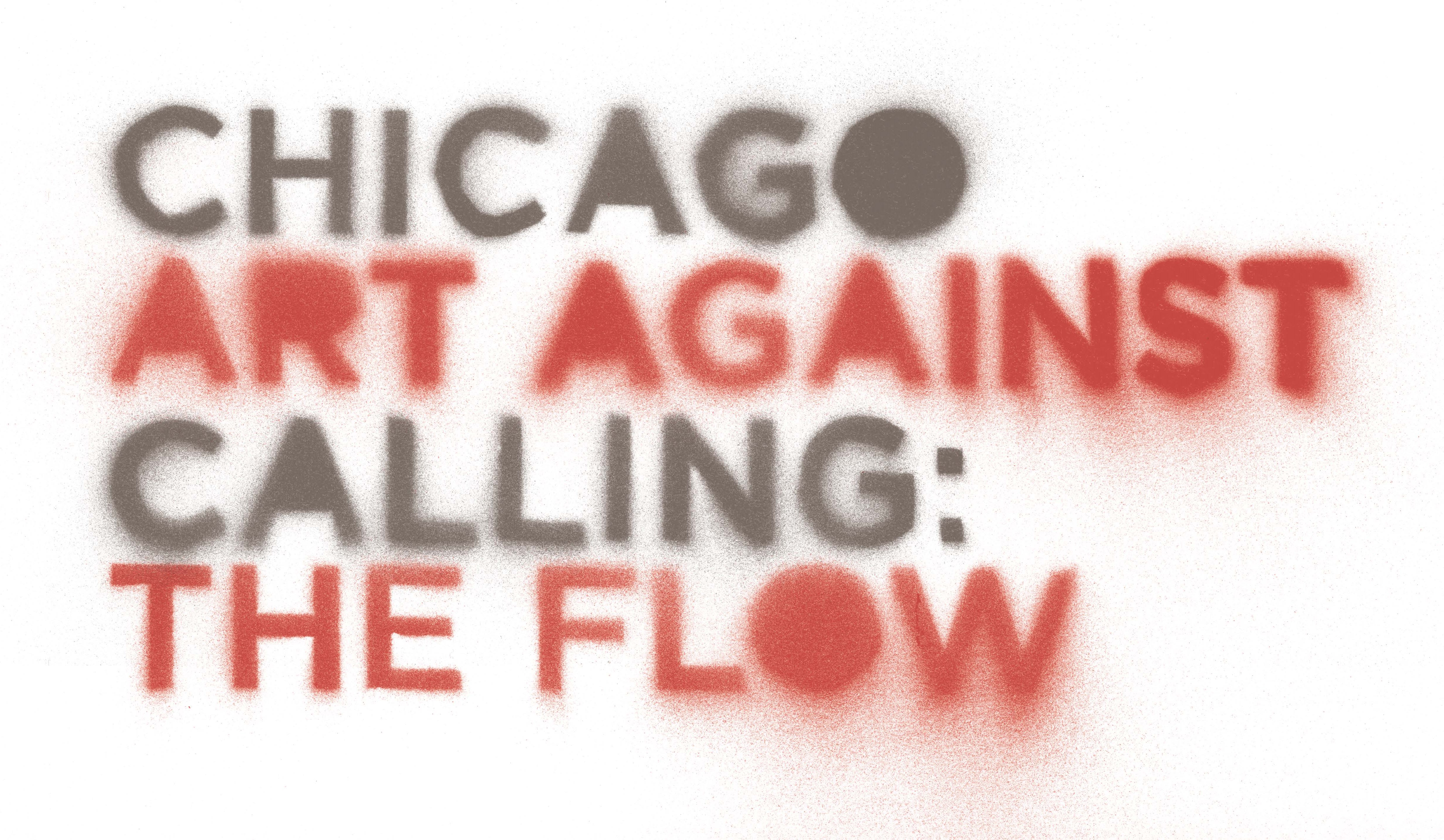
In the exhibition catalog for Chicago Calling: Art Against the Flow, curators Kenneth Burkhart and Lisa Stone push against the idea that there is a specific outsider aesthetic, in favor of what they call a “semantic ecotone.” They write that this perspective is borrowed from the ecological concept of ecotone, or the transition between two different planes of ecological communities. Ecotones are characterized by vague border and boundaries and by the potential for both mutual dependence and competition. Burkhart and Stone ask readers to consider a “semantic ecotone” in terms of outsider art–proposing that the boundaries between the academy and the non-academic are perhaps not as separate as some may view it to be and instead part of a larger, interdependent arts ecology.
Looking at outsider art through this lens helps answer one of the foundational questions asked in the exhibition catalog, “Why are there so many great self-taught/outsider artists in Chicago?” The ten artists highlighted in the show–Henry Darger, William Dawson, Lee Godie, Mr. Imagination, Aldo Piacenza, Pauline Simon, Drossos Skyllas, Dr. Charles Smith, Wesley Willis, and Joseph Yoakum–demonstrate Chicago’s flexible arts ecology.
Henry Darger, arguably Chicago’s most famous outsider artist, was born in Chicago in 1892 and by the age of 12 was committed to the Asylum for Feeble-Minded Children in Lincoln, Illinois. After two attempts of escaping the institution, Darger eventually was successful and returned to the city where he found work as a janitor at a Catholic hospital. It was during this time that he created his well-known work The Story of the Vivian Girls, in What Is Known as the Realms of the Unreal, of the Glandeco-Angelinian War Storm, Caused by the Child of the Slave Rebellion. This work, which exists over the span of 15,000 pages and hundreds of related collages, spins the tale of seven young sisters called the Vivian Girls who are depicted as both gender fluid and brave as they journey to free children from slavery.
Chicago Calling: Art Against the Flow showcases Darger’s work alongside sculptures by Dr. Charles Smith, who grew up in the Chicago area in the 1940s and 50s. In the exhibition catalog, Burkhart and Stone write that Smith’s memories of attending the funeral of Emmet Till at the age of 15 and his experiences in combat as a marine in the Vietnam War had a deep impact on his work as an artist. He felt he was divinely inspired with a vision to direct his anger at the pervasive racism in America and his suffering during his military service into art. In 1986, he began creating signs and sculpture in tribute to the more than 7,000 African Americans who died during the Vietnam War, which he placed as a site called “The African-American Heritage Museum and Black Veteran’s Archive” in Aurora, IL. The pairing of Darger’s illustrations (one in particular showing the brutalization of children) alongside Smith’s sculpture which embody expression of pain, poverty, and defiance is striking.
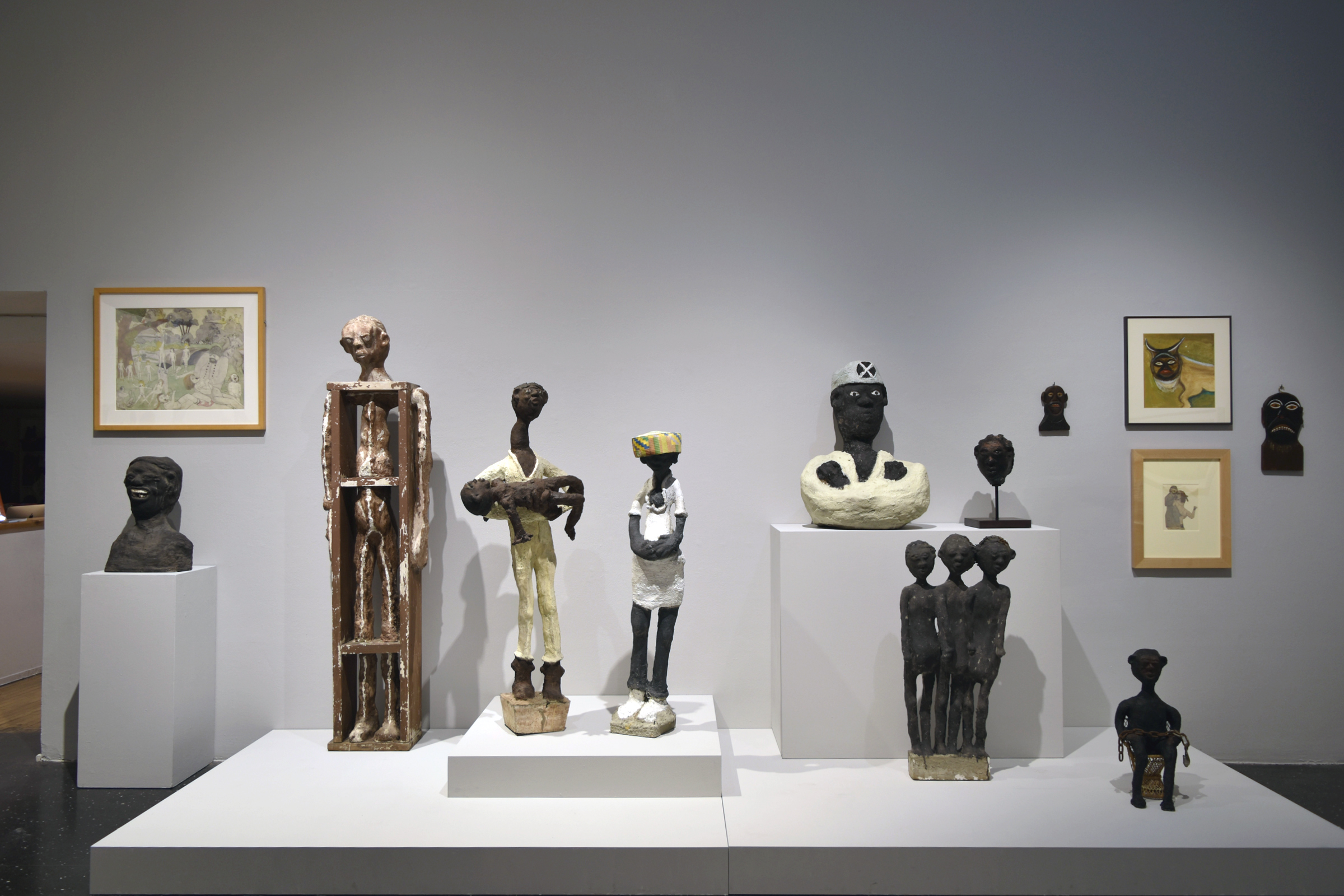
Smith’s work is also shown alongside that of William Dawson, a produce distributor who started his art career after semi-retiring. Dawson’s sculptures, usually made from whittling found wood, depict animals, ships, pop culture figures, totems, and his friends. Dawson was a prolific artist once he began creating, and Burkhart and Stone write that he created a new piece every day. His work is instantly recognizable by the deep features, almond shaped eyes, down-turned mouths, and formal stature. They write that in previous exhibitions, Dawson’s sculptures are shown in massed installations. However, for Chicago Calling: Art Against the Flow, Burkhart and Stone intentionally pulled out single examples of his work to allow the viewer to fully meditate and absorb the themes and ideas present. Dawson’s work is paired with both Wesley Willis’s seemingly-agitated architecture drawings and Aldobrando Piacenza’s handmade birdhouse cathedrals.
Aldobrando Piacenza was Italian-born entrepreneur who emigrated to the United States in 1903. He spoke no English when he arrived and worked in a factory, as a street vendor, in a hotel, bakery, and saloon. Burkhart and Stone write that Piacenza sent most of his earnings back to family in Italy throughout his life. After retiring in 1952, Piacenza began constructing his bird-house models of churches and cathedrals. He based his work off of newspapers, postcards, and National Geographic. His birdhouses, constructed from scrap wood, sheet-metal roofing, and glossy enamel paint, speak to Piacenza’s affinity for the handmade, similar to many of the artists in the exhibition.
Burkhart and Stone write that Wesley Willis was positively possessed by Chicago’s build landscape, in particular its skyscrapers, the pathway of the Chicago river, and the Dan Ryan Expressway. Born in Chicago, Willis grew up in Chicago Housing Authority projects and foster homes on Chicago’s South Side. His drawings reflect his intimate knowledge of the Chicago landscape, and when he was 18 he met architect Paul Young who took interest in Willis’s drawings. After attending one of Young’s classes at the Illinois Institute of Technology (IIT) for five years, Willis was given a studio space at S. R. Crown Hall, Ludwig Mies van der Rohe’s 1956 architectural feat and home to the College of Architecture at IIT. At the age of 26, Willis was diagnosed with schizophrenia and started hearing what he referred to as “demon voices.” Burkhart and Stone sum up Willis’s work by saying, “His drawings are a staccato of Chicago-Chicago-Chicago, the city observed, condensed, and magnificently delineated.”
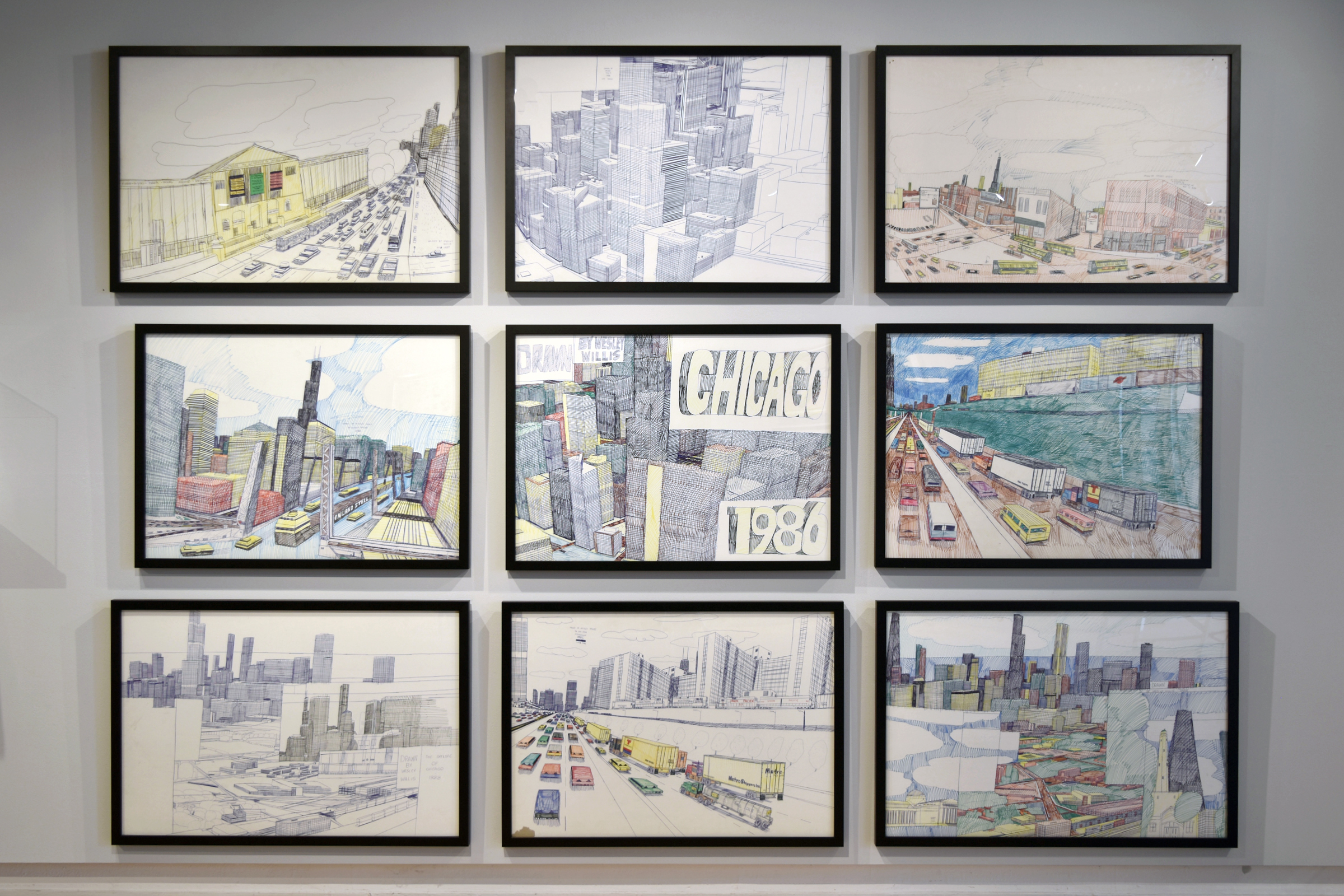
The curators also skillfully paired paintings by Lee Godie, Chicago’s self-proclaimed French Impressionist, with two paintings of a nude by Drossos Skylas. Both artists frequented the Art Institute of Chicago and showed their work three times–Skylas in the galleries of the museum and Godie on the street outside, according to Burkhart and Stone. Lee Goodie was born in Chicago in 1908 and suffered the loss of her two children in the 1960s. Godie was a famous self-promoter and despite being homeless, earned recognition during her lifetime for her paintings and photographs. She had no need for the formal aspects of the art world such as galleries, dealers, critics, or a bank, and sold her paintings on the steps of the Art Institute of Chicago.

Burkhart and Stone write that Drossos Skylas’s work stands out from “other celebrated self-taught artists due to this technical proficiency and the inspiration he drew from art history.” His sources ranged from Byzantine mosaics to Playboy magazine. His nudes, landscapes, portraits, and religious paintings take on an “idyllic, iconic realism, and uncanny perspective.” Born in Greece, Skyllas emigrated to Chicago at the end of World War II. He was self-educated and frequently visited the Art Institute of Chicago. It was only after his death in 1973 that his work was discovered by a prominent gallery director who featured it as a solo show. Following that, Skylas’s work was featured in a number of exhibitions, including at Intuit in 1995.

Skylas’s work is paired in the exhibition with the work of Joseph Elmer Yoakum, originally from Missouri. Yaokum had a circus career and served during World War I. In the late 1920’s, Yaokum relocated to Chicago and retired 30 years later. It was at this point that he began making art–mostly landscapes, portraits of famous African Americans, and clay sculptures. While there were early appreciators of his work, he did not have solo exhibitions until a year before his death in 1973. Burkhart and Stone imagine that Yaokum’s landscapes, created in the last chapter of his life, represent “distilled earlier experience of wandering the country and distant lands into drawings that perfectly express ideas of the ineffable feeling of places on earth: all manner of land formations, foliate forms, waterways and oceans, and the realm above–cloudscapes and his iconic suns.”

Another adept pairing in the exhibition is that of Pauline Simon and Mr. Imagination. Pauline Simon, originally from Russia, emigrated to Chicago at the age of 22. After retiring in her 70s, Simon began her art career by taking a member painting class at the Art Institute of Chicago. Following that, she continued taking classes at Chicago institutions such as the Hyde Park Art Center and painted until her death in 1976. During her later life, she studied with artist and curator Don Baum, known for his extensive efforts in promoting the work of Chicago artists. Burkahart and Stone write that Baum’s commitment to the work of Simon gave her the confidence she needed to craft her own artist perspective. Her portraits of women nod clearly to the history of the painted portrait. Interestingly, the curators paired a handful of her pieces in the show with highly embellished Mr. Imagination pieces.
Mr. Imagination is known for his intricately adorned sculpture that Burkhart and Stone say echo ancient and royal artifacts.They write that he barely escaped an oppressive life of the high-rise and low-income housing project Robert Taylor Homes, and situated himself in many Chicago neighborhoods following that. He dispersed his found-object pieces across the city in a multitude of restaurants, bars, and shops. Unlike some of the other artists featured in the show, Mr. Imagination’s career developed greatly while he was living. The curators write that the Mr. Imagination works selected for Chicago Calling: Art Against the Flow were meant to showcase a variety of aspects of his “expressive abilities and personality, the grand and the modest.”
The reception to the show has been so overwhelming that Intuit has decided to keep it open through February 10, 2019–over a month longer than originally planned. The center plans to offer additional programming opportunities during this extension such as a Piacenza-inspired cardboard construction workshop on Saturday, January 19 and a closing reception on Thursday, February 7.
Featured Image: Wesley Willis (American, 1963-2003). The Chicago Skyline, Sears Tower, Chicago River…, 1986. The illustration shows a bridge open above the Chicago river as a boat passes below it. In the background is a cityscape of downtown Chicago. Ballpoint pen and felt tip pen on board, 28 x 42 in. (71.12 x 106.68 cm.) Collection of Rolf and Maral Achilles.
 Emily Breidenbach is an arts administrator with experience working at museums, education centers, and non-profits. She is currently the Assistant Director of Marketing and Enrollment for Continuing Studies at the School of the Art Institute of Chicago (SAIC) and has previously managed strategic communications for the Krannert Art Museum, the Frank Lloyd Wright Foundation, and the Museum Education department at the Art Institute of Chicago. She has a B.F.A. in Art History from the University of Illinois at Urbana-Champaign and is currently pursuing a M.A. in Arts Administration and Policy at SAIC.
Emily Breidenbach is an arts administrator with experience working at museums, education centers, and non-profits. She is currently the Assistant Director of Marketing and Enrollment for Continuing Studies at the School of the Art Institute of Chicago (SAIC) and has previously managed strategic communications for the Krannert Art Museum, the Frank Lloyd Wright Foundation, and the Museum Education department at the Art Institute of Chicago. She has a B.F.A. in Art History from the University of Illinois at Urbana-Champaign and is currently pursuing a M.A. in Arts Administration and Policy at SAIC.


